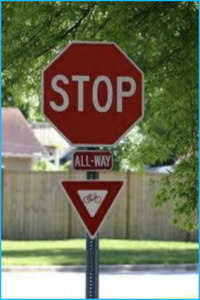Safety: Top Ten Bicycle Laws
 TOP 10 LIST of Common Oregon and Washington Bicycle Laws
TOP 10 LIST of Common Oregon and Washington Bicycle Laws
Every PBC ride route includes some interaction with cars, trucks, and pedestrians. To that point, everyone should have an accurate knowledge of bicyclist-related laws that keep riders safe when interacting with vehicular traffic. Oregon and Washington publish those bicyclist-related laws (applicable publications/links to follow) in great legal detail. This article highlights a few of the more common laws that may be misunderstood or misrepresented.
The State of Oregon published a great OREGON BICYCLING MANUAL (5th Edition). With references labeled OBM (Oregon Bicycle Manual), the link is https://www.oregon.gov/odot/programs/pages/bikeped.aspx. ✎
The State of Washington provides an informative website titled Bicycling in Washington to “find information about bicycling in Washington, including resources for route planning on state routes and ways to extend your bicycle trip by bringing your bike on board other transportation modes.” “Washington State was named the nation’s number one “Bicycle Friendly State” by the League of American Bicyclists for seven years in a row”: https://wsdot.wa.gov/travel/bicycling-walking/bicycling-washington.
The State of Washington also provides a detailed website titled Bicyclist Laws & Safety to “learn about bicyclist-related laws, safety tips and the rights and responsibilities you have as a bicyclist.” With references labeled RCW (Revised Code of Washington), https://wsdot.wa.gov/travel/bicycling-walking/bicycling-washington/bicyclist-laws-safety
#1. OBM page 25 – “In Oregon, people riding bicycles are allowed to treat stop signs and flashing red lights as YIELD signs.”
#2. RCW 46.61.190 (b)(i) Amended by SSB 6208 (2/12/20) – “A person operating a bicycle approaching a stop sign must either stop or follow the requirements for approaching a yield sign.”
#3. RCW 46.61.755 – “Every person riding a bicycle upon a roadway shall be granted all of the rights and shall be subject to all of the duties applicable to the drivers of a vehicle.”
#4. OBM page 22 – “You must come to a complete stop at solid red lights at intersections. When approaching an intersection with a solid yellow light, it is the law to stop at the yellow light if you are not already in the intersection.” Same law required in Washington State.
#5. OBM page 15 – “Ride to the Right or Take the Lane?” In some conditions it is best to ride closer to the center or “take the Lane.” In Oregon, if there is a bicycle lane on a street, you are required to ride in it except: “avoiding hazards, avoiding parked cars, too narrow a road lane, making left turn, conflicts with right turning cars, or one way streets.”
#6. OBM page 8 – “Oregon law requires all bicycle riders under the age of sixteen to wear an approved helmet while riding on a public path or roadway. However, it is recommended that all people wear a helmet when riding bicycles to help prevent or lessen the severity of a potential head or brain injury.”
#7. Bicyclist laws & safety – Currently, there is no Washington State law requiring the wearing of bicycle helmets. Some cities (including Vancouver, WA) do require helmets for all ages.
 #8. OBM page 24 – “Many traffic signals are triggered by electronically charged wires buried under the pavement. Depending on the shape, the most sensitive spots are: “Diamonds: just inside one of the points. Rectangles: up front, in the middle. Circles: about ¼ of the way in.
#8. OBM page 24 – “Many traffic signals are triggered by electronically charged wires buried under the pavement. Depending on the shape, the most sensitive spots are: “Diamonds: just inside one of the points. Rectangles: up front, in the middle. Circles: about ¼ of the way in.
#9. RCW 46.61.770 – When there is sufficient space on the roadway or pathway, riders may ride side by side; but, not more than two.
#10. RCW 46.61.780 – “For night bicycle riding, a white front light (not a reflector) visible for 500 feet and a red rear reflector are required. A red rear light may be used in addition to the required reflector.” Similar law, required in Oregon.
Richard Higgins, Member at Large
